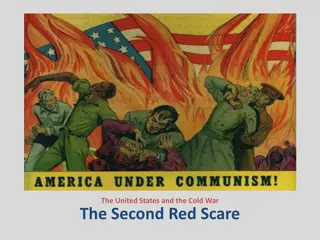Causes Behind the Decline of the Mughal Empire
The decline of the Mughal Empire was influenced by weak successors after Aurangzeb, degeneration of Mughal nobility, inefficiency of the army, economic bankruptcy, foreign invasions, wars of succession, and court factions. The empire faced challenges such as incompetent rulers, weakened military, fi
2 views • 5 slides
England in the Restoration and Eighteenth Century: Political Evolution and Social Transition
Following years of civil wars and revolution, England saw significant political shifts from the Restoration period in the 1660s to the Eighteenth Century. The monarchy was restored, leading to the emergence of Whig and Tory political factions, battles for religious dominance, and the growth of Briti
2 views • 14 slides
Post-WWII America: Progress, Politics, and the Election of 1948
Lakewood, California's post-WWII boom symbolized the era's prosperity and status symbol of homeownership. Truman's Fair Deal faced Republican opposition, leading to postwar political shifts, including the 22nd Amendment and Taft-Hartley Act. The Election of 1948 saw Truman navigating Democratic fact
0 views • 20 slides
Trends in U.S. Political Landscape: Polarization and Party Dynamics
The analysis delves into the evolution of the U.S. political scene, highlighting shifts in party majorities, polarization among liberals and conservatives, maintenance of moderate factions, the significance of independents, and the dominance of centrist issues. It explores the challenges posed by th
0 views • 37 slides
The United States and the Cold War: Historical Overview
The content explores the dynamics of the Cold War, focusing on China's internal conflict, the Korean Peninsula division, and the impact of the Second Red Scare in the United States. It delves into the feuds between different factions in China, the rise of communism, the Korean War phases, and the do
0 views • 15 slides
Political Unrest and Power Struggles in Ancient Rome
In the Late Republic of Rome, conflicts between the plebeians and the Senate often led to internal discord and power struggles. The tensions escalated over time, culminating in instances of armed strife and civil war. Leaders like Marcius Coriolanus and Tiberius Gracchus played significant roles in
0 views • 40 slides
The Thirty Years War: Bohemian Revolt and European Conflict
The Thirty Years War began as a clash over political and religious issues with the Bohemian Revolt in 1618. Despite initial intentions for limited involvement, major powers were drawn into a prolonged conflict lasting three decades. The war involved various factions, including Protestant assemblies,
0 views • 20 slides
Understanding Political Parties and Factional Politics
Political parties are groups with shared values aiming to win power through elections. They produce manifestos outlining their policies. Factions within parties may support different leaders or policies, influencing party dynamics. Parties play essential roles in shaping government policies and enga
0 views • 24 slides
Understanding Federalist Papers: Factions and Government
Discover the essence of Federalist Papers through an exploration of factions, democracy, and governance. Learn about the dangers of factions, their causes, and remedies proposed by James Madison. Dive into the significance of factions in shaping governmental decisions and the importance of safeguard
0 views • 31 slides
Understanding State Terrorism and Its Implications on Society
State terrorism, employed by governments or factions within them, poses a grave threat to citizens and international peace. This form of terrorism includes intimidation, coerced conversion, and genocide as tools to maintain control. Dictators find it easier to carry out state terrorism in secret, of
0 views • 7 slides









